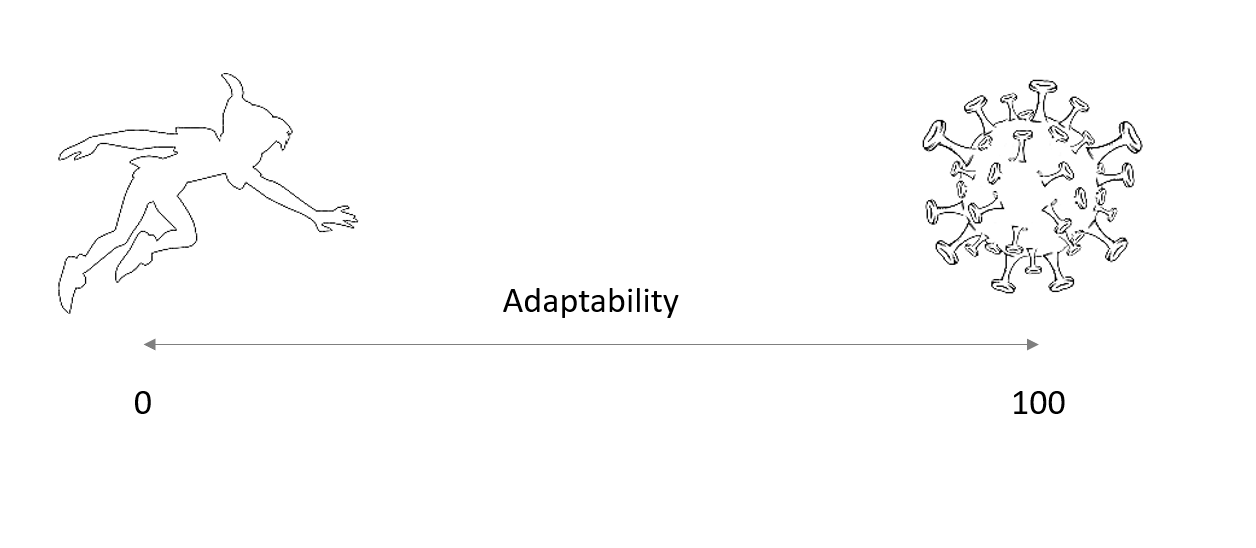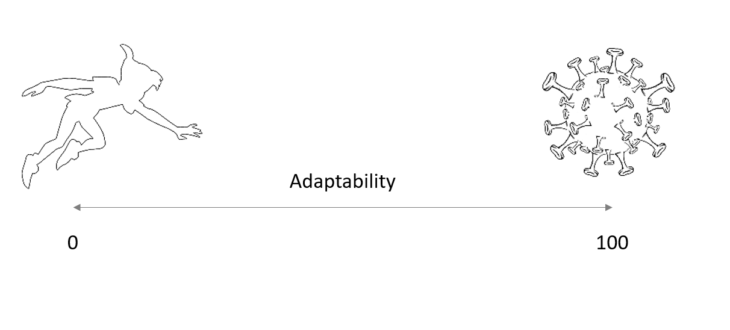What do NASA, the Third Reich, and a cloistered nunnery have in common? All of them are organizations far removed from the criteria of economic profitability. In them, money is not an end, but a means, because what is pursued is an idealistic goal, be it the reign of Jesus Christ on Earth, Hitler’s in Europe, or America’s in heaven.
Selective pressure makes most successful organizations tend to put their own survival before the goals and mission of the organization itself.
The most intuitive way in which this happens (although not the only one) is the tendency among managers and employees of organizations to ensure their own survival in it, and if necessary, betray the objectives of their organization to stay in the position and thrive. As they do so, they help keep the organization alive and healthy, although perhaps far from its mission.
Furthermore, vanity is not an economic resource and the vision of oneself as an indispensable messianic leader emerges spontaneously without much difficulty. I dare say that this happens even in positions of little responsibility.
Of course, this is not a binary issue but a gradual one. You can be both at the same time, you can alternate one policy and another, and so on.
In a Cartesian metaphor, we could put unscrupulous organizations at the extreme that like a cancer do everything possible to spread and survive without any criteria. Its adaptation to a changing environment is maximum. We could call them “Virus” organizations.
At the other extreme would be idealistic organizations that base their performance on criteria (axiological and deontological) immutable and independent of the reality that surrounds them. Their adaptation to a changing environment is minimal. Due to their idealistic character bordering on fantasy, we could call them “Peter Pan” organizations.

We might think that the organizations mentioned in the first place (the “Viruses”) are frequently large and successful, while the “Peter Pan” ones are modest, short-lived and easily bankrupt. In fact, we have many examples:
- Big “Viruses” are basically all the big for-profit organizations. Specifically, we can think of companies like Amazon, Microsoft, Google, Apple or Facebook. Although they have a mission and are not complete viruses, they come very close to this idea of maximum adaptability for maximum evolutionary success (maximum growth, maximum reproduction).
- Small “Peter Pan” are typically all small non-profit charities, cultural associations, family structures made up of childless couples, minority political parties, artisanal manufacturing (in which product quality is prioritized over financial performance), a dating service for long-term relationships, the projects of most artists, educators and other professions and vocational activities, etc.
But this is not always the case, far from it:
- Small “Viruses”: innumerable projects without criteria are unviable and disappear shortly after birth, being identified by the immune system as toxic or dysfunctional elements, receiving the suspicion and mistrust of donors, citizens, patients, clients and investors. A couple of examples are scams and failed attempts to “hit the ball.”
- Big “Peter Pan”: in the most important historical phenomena such as religions, humanism or imperialism; as well as some of more recent but undoubted success such as feminism or anti-racism; and in other incipient and promising ones, such as antispeciesism and veganism, there are organizations quite close to the “Peter Pan” model. For example: churches, governments (of the Third Reich, the imperialism of Alexander the Great), social organizations (PETA), political parties, the public health and social security system… in all of them we can find cases of large, highly successful organizations guided by purely idealistic criteria.
What should organizations be like? What is the optimal point?
For example, if there were a donor who wanted to dedicate an economic amount to a specific purpose, maximizing its impact, and the target organization was indifferent, where should the recipient organization be located, in this axis of “Adaptability” that goes from “Peter Pan” to “Virus”?
The question, with certain adaptations, is relevant both in the field of solidarity and non-profit organizations and in the field of work, business and investment. In the first environment, our altruistic goal may be to eradicate malaria, alleviate the suffering of cluster headaches, end world hunger, prevent animal suffering in factory farming, or assure dying patients a dignified death. and without avoidable suffering. What level of organizational adaptability is ideal to achieve this goal? What organization should we donate to? We can also make a similar reflection if what we want is to obtain, selfishly, the maximum profitability of our time and money, and we want to do it in a certain way or in a certain sector in particular, since, for example, we are following an intuition. For example, if we believe that the energy of the future goes through nuclear and uranium, or instead renewables are inevitable, or if we believe that we should colonize Mars, or bet on new data transmission technologies, or Artificial Intelligence? What type of company should we invest in?
As there are many other factors, there can be no single answer to this question of the optimal degree of “Adaptability”. Depending on other considerations such as the historical moment, the challenge we face or the competition we have, the optimal point of “Adaptability” will be found in one place or another.
In any case, it seems intuitive to me that there is a range of possible positions where the optimum can most likely be found. For example, it seems intuitive to me that both extremes seem problematic and that it will be rare for the optimum to be at either extreme. With this I do not mean that there are no organizations that enjoy good health being complete “Viruses”. Sure there are, and possibly some “Peter Pan” ones too. What I mean is that if what someone wants is to achieve a certain goal, it will seem strange to me that a purely “Virus” or purely “Peter Pan” organization was the best way to achieve it.
I have other intuitions that have been nuanced over time. For example, I have always thought that the best money spent will be in donations to organizations closer to “Peter Pan” than to “Virus”, and I still think so, as long as we consider the donation in isolation. For me, the fact that an organization is small, young and that is in financial difficulties can be the consequence of a character with a tendency to “Peter Pan” that ensures the efficient use of my donation, considering this donation as an isolated event. If we can also come into direct contact with those responsible for the organization and be informed promptly of progress, I think we can achieve sufficient confidence that the money will be well spent.
However, other much larger organizations that even divert a large part of the resources they receive to expenses that have nothing to do with their mission, can have a much more positive overall effect with that percentage that they do use in line with the objective . In other words, my donation to a “Peter Pan” organization may be the most effective donation that I can make. But at the same time, it may happen that a certain “virus” effect is inevitable to reach many more donors.
Reasons to stop being “Peter Pan”
There are times when it might appear that a “Peter Pan” organization is behaving like a “Virus” when it is not. For example, the money raised from the first investor in the business we want to start could be spent on a big party or expensive gifts whose sole purpose is to attract the attention of a second investor. Or the money raised from a large donation made to an NGO trying to help earthquake victims could be spent in full on a large publicity campaign to attract even more donors.
I can imagine the face of the first investor if the second investor does not arrive (and even if it arrives). I can also imagine the perplexity of someone who makes a donation to an urgent charitable cause and watches as their money is consumed in television commercials instead of being transformed into food, water, blankets and medicines. But all this is nothing more than a question of strategy and of balancing the expected benefit and the risk. If with 20,000 euros we could ensure the arrival of an investor with two million euros, or if with those same 20,000 euros we could ensure the arrival of two million euros in aid, we would not hesitate. It would seem to us the best invested money in the world.
While it may seem extremely difficult and unpredictable to attract a large investor to our project, or to have great success in a media campaign, it is not at all unreasonable to think that there are people who have great skills in this regard, whether in conventional actions or eccentric, whether in classic or controversial campaigns.
It seems clear to me that some people will be better than others in charge of these initiatives and there must be some really good people doing tasks like attracting investors or convincing the general public to react to an emerging need. If we could work with one of these people, would we hire them? Even if it was not aligned with the values of the organization? Even if their salary was excessive, totally outside the range of what is considered appropriate in our small NGO? Even if their public behavior was embarrassing to us? Maybe yes, maybe no. Probably we are flexible to certain limits that we are not willing to cross.
This specific crossroads may occur occasionally, but it is not something isolated. Somehow, in the evolution of organizations, these types of situations are constantly produced. For example, in an NGO, do we hire a person highly aligned with the objectives of the organization? Obviously yes, and this happens all the more the smaller the NGO is. But let’s look at the situation from another perspective: if our organization grows abruptly, so that it becomes difficult for us to find the right profiles to fill the different positions, and we have an employee in the NGO who does an excellent job, receiving an adequate salary, and with whom the entire organization is delighted, but who over time experiences an ideological misalignment with the NGO’s values, should we do without them and look for a new person, destabilizing and stressing the entire organization even more? I bet, in countless cases, no.
In this way, and if they succeed, organizations that are born as small “Peter Pan” are getting closer to the form of “Virus”, to survive, to stabilize, to grow and to continue fulfilling their mission with maximum efficiency and maximum impact. If we want to create an NGO, it seems to me that this is a phenomenon inevitably linked to success, which must be known and accepted, in order to monitor and control it, in an approach that tries to maximize the positive impact and the mission that we have proposed. And we must monitor and control it because if our little idealistic “Peter Pan” gets too infected with the survival attitude of the “Virus”, then we could be creating a monster without sense, remote or even opposed to our objective.

1 Comment